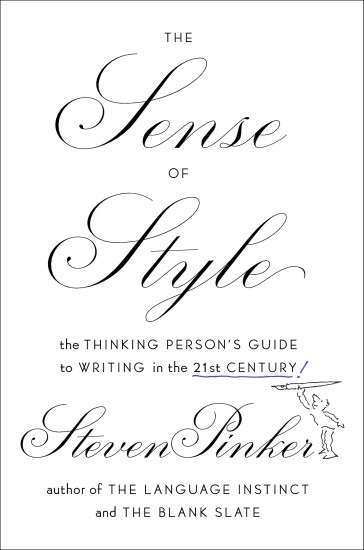
It’s that time of year again.
Spring cleaning.
A time for clearing closets and cupboards of contents that have accumulated over the winter. Or in my case, completing a book that’s been lurking on the shelf just as long.
Make that twice as long.
Two years ago, while tuning into NPR’s A Way with Words, I heard one of the hosts extolling the virtues of Steven Pinker’s newest work. As I cruised my way home that Sunday afternoon, I contemplated how soon I might obtain a copy.
As it happened, one appeared in my library’s new books section the following week.
I love the new books shelf. Any time I browse, it’s nearly impossible for me to leave without a selection. Or two. Or three. It’s the reason a college friend once observed that I probably brought half the collection home with me over the course of a year. She wasn’t too far from the truth.
Thus, while Pinker’s prose landed on my bookshelf without delay, it wasn’t long before other books followed suit. And as the chronology of my blog posts reveal, they’ve made their way toward the front of the reading queue while their predecessor has waited. And waited.
I finally decided I’d deprived other library users of Pinker’s book long enough. It was time. My initial enthusiasm, however, had waned. A 300-page writing manual? Really?
Fortunately, as I consulted “the thinking Person’s guide to writing in the 21st century,” I was relieved to encounter more than just a lecture on diagramming sentences. And I’m not just referring to the cartoons and comic strips sprinkled throughout the text.
Unlike other writing guides, Pinker doesn’t just list rules and how to apply them; he explains how they work and why they ought to be employed:
“The use of consistent grammar reassures a reader that the writer has exercised care in constructing his prose, which in turn increases her confidence that he has exercised care in the research and thinking behind the prose.”
In other words, your message gains credibility when it follows well-established writing traditions. Tradition, however, is a tricky thing, and as the people using language change over time, so does the language itself. Hence the reason for Pinker’s tagline; our ways of thinking about writing are bound to look different from one generation to another.
One of the dangerous things about reading about writing is that you quickly become conscious and critical of your own habits. Did I split an infinitive? Have I negligently used commas? Am I guilty of apostrophe abuse?
Fortunately, Pinker isn’t out to condemn anyone. At the end of the day, he reminds readers that good style isn’t about keeping all the rules, but rather, applying them in a thoughtful manner to contribute ideas and beauty to our world. Understanding how to use language helps a writer untangle her “swarm of ideas” and convey their meaning to an audience. Good writing isn’t an accident; it’s a designed object with harmony and balance.
Maybe it’s because I’ve just curated three bags of Goodwill donations, but producing good writing requires a similar kind of thoughtful decision making that’s helpful when shopping. If you’re not careful, you might accumulate superfluous items that take up space without adding value.
Otherwise, you’ll be spending a weekend like I spent mine:
Spring cleaning.